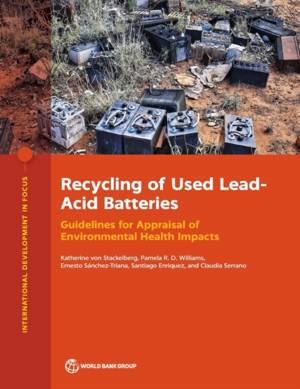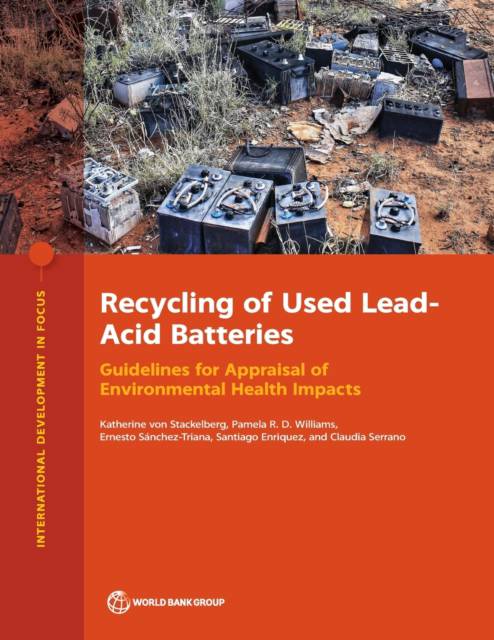
- Afhalen na 1 uur in een winkel met voorraad
- Gratis thuislevering in België vanaf € 30
- Ruim aanbod met 7 miljoen producten
- Afhalen na 1 uur in een winkel met voorraad
- Gratis thuislevering in België vanaf € 30
- Ruim aanbod met 7 miljoen producten
Zoeken
Recycling of Used Lead-Acid Batteries
Guidelines for Appraisal of Environmental Health Impacts
Katherine Von Stackelberg, Pamela R D Williams, Ernesto Sánchez-Triana, Santiago Enriquez
€ 62,45
+ 124 punten
Omschrijving
This document includes a pragmatic framework for designing representative studies and developing uniform sampling guidelines to support estimates of morbidity that are explicitly linked to exposure to land-based contaminants from used lead acid battery recycling (ULAB) activities. A primary goal is to support environmental burden of disease evaluations, which attempt to attribute health outcomes to specific sources of pollution. The guidelines provide recommendations on the most appropriate and cost-effective sampling and analysis methods to ensure the collection of representative population-level data, sample size recommendations for each contaminant and environmental media, biological sampling data, household survey data, and health outcome data. These guidelines focus on small-scale ULABs that are known to generate significant amounts of lead waste through the smelting process, as well as other metals including arsenic and cadmium. A primary concern with lead exposure is the documented association with neurodevelopmental outcomes in children as demonstrated by statistically significant reduced performance on a variety of cognitive tests. These associations are evident even in the youngest children, and toxicological and epidemiologic data indicate these effects have no threshold. Other potential exposures include arsenic and cadmium, and exposure to these contaminants is also associated with neurodevelopmental outcomes in children, as well as arsenicosis; bladder, lung, and skin cancers; and renal outcomes. The primary objective of this document is to guide research to assess the relationship between environmental contamination, exposures, and health outcomes related to a subset of contaminants originating from ULAB activities for particularly vulnerable populations (such as children) and the general population within a single household in the vicinity of ULAB sites in low- and middle-income countries. To achieve this objective, biomonitoring and health outcome data are linked to household survey and environmental data (for example, soil, dust, water, and agricultural products) at the individual level from an exposed population compared to individuals from an unexposed (reference) population. Data on exposures and health outcomes in the same individual, across a representative set of individuals, is required to support an understanding of the potential impact of ULAB activities on local populations. The guidelines can also assist in building local capacity toconduct environmental assessments following a consistent methodology to facilitate comparability across ULAB sites in different geographic areas. Sampling strategies and methods are prioritized given information needs, resource availability, and other constraints or considerations. The document includes a number of supporting appendixes that provide additional resources and references on relevant topics. Data obtained following these recommendations can be used to support consistent, comparable, and standardized community risk and health impact assessments at contaminated sites in low- and middle-income countries. These data can also be used to support economic analyses and risk management decision-making for evaluating site cleanup and risk mitigation options in the most cost-effective and efficient manner. Following these recommendations will facilitate comparisons and meta-analyses across studies by standardizing data collection efforts at the community level.
Specificaties
Betrokkenen
- Auteur(s):
- Uitgeverij:
Inhoud
- Aantal bladzijden:
- 118
- Taal:
- Engels
- Reeks:
Eigenschappen
- Productcode (EAN):
- 9781464818202
- Verschijningsdatum:
- 21/07/2022
- Uitvoering:
- Paperback
- Formaat:
- Trade paperback (VS)
- Afmetingen:
- 216 mm x 279 mm
- Gewicht:
- 399 g

Alleen bij Standaard Boekhandel
+ 124 punten op je klantenkaart van Standaard Boekhandel
Beoordelingen
We publiceren alleen reviews die voldoen aan de voorwaarden voor reviews. Bekijk onze voorwaarden voor reviews.








